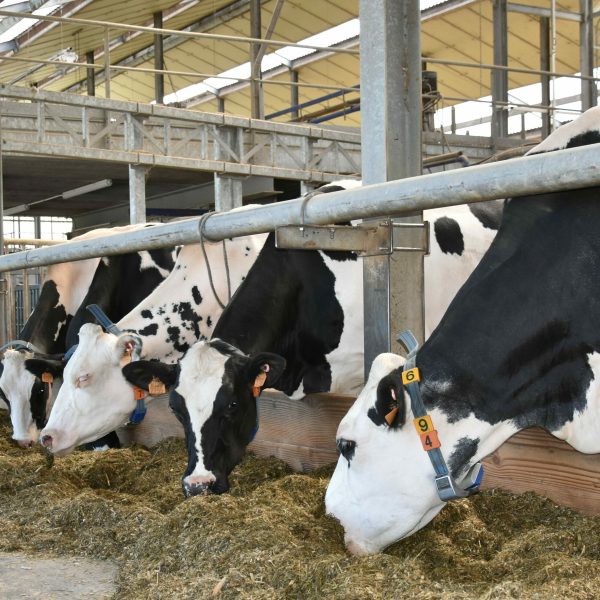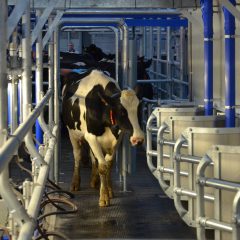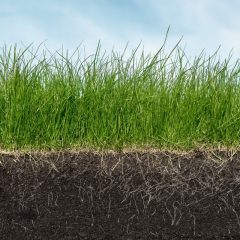Dossier Methane emissions in livestock farming (enteric emissions)
Enteric emissions are the methane emissions that arise mainly during fermentation in the rumen of ruminants such as cattle. These emissions form a significant part of total greenhouse gas emissions from agriculture and help determine the climate impact of meat and dairy farming.

What does ILVO do?
-
 ILVO is investigating the potential of measures to reduce methane emissions from cattle.
ILVO is investigating the potential of measures to reduce methane emissions from cattle. -
 ILVO can measure methane emissions from its own dairy cattle in the barn and on the pasture.
ILVO can measure methane emissions from its own dairy cattle in the barn and on the pasture. -
 ILVO supports policymaking by participating in the Covenant for Enteric Emissions by Cattle 2019-2030.
ILVO supports policymaking by participating in the Covenant for Enteric Emissions by Cattle 2019-2030.
Greenhouse gases: a question of balance
Carbon dioxide (CO2), methane (CH4) and nitrous oxide (N2O) are natural greenhouse gases. They play an important role in the quality of life on our planet by naturally retaining some of the solar energy in the atmosphere that lands on the earth. Without these greenhouse gases, the average annual temperature on Earth would not be +15°C as it is today, but only -18°C. However, an excessive concentration of greenhouse gases raises the average annual temperature and in the process causes global warming.
Methane: quick and dirty
Each greenhouse gas has a specific warming potential. For example, this power of CH4 is 28 times higher than that of CO2. However, methane has a relatively short lifetime in the atmosphere (12 years). Methane-reducing measures therefore have a visible climate effect within one generation.
What is the impact of livestock farming?
The agricultural sector is responsible for 10% of total greenhouse gas emissions in Flanders. Of that 10%, about half is methane (49%). Most of those methane emissions come from enteric fermentation (70%). The remaining 30% are emissions from manure and manure storage. In addition to having a warming effect on our earth, methane emissions also cause a loss of feed energy. About 5 to 12% of the energy absorbed from feed exits the (cow's) body without being 'used' - in the form of methane.
How do enteric emissions arise?
Enteric emissions occur during the fermentation of carbohydrates and crude fiber in the rumen. Here, microorganisms break down the ingested feed into volatile fatty acids, which serve as building blocks for the ruminants' bodies. In addition to these volatile fatty acids, microorganisms also release hydrogen gas (H2). To maintain optimal rumen fermentation, this H2 must be removed. Methanogenic bacteria take care of this. They bind the H2 with CO2 to form CH4 and H2O. The methane gas leaves the body via the mouth while the cow chews her cud and exhales.
Contrary to popular belief, the amount of methane leaving the body from the cow's rear end is very limited. Indeed, only 10% of total enteric emissions are formed in the large intestine - the other 90% are formed in the rumen.
Not all volatile fatty acids turn into methane
The abovementioned microbial fermentation described above gives ruminants the great advantage of being able to convert high-fiber feeds such as grass into high-quality protein (their meat and milk). Methane production is the big downside of this. Fortunately, not all of the volatile fatty acids formed during carbohydrate digestion ultimately produce methane. The formation of the fatty acids acetic acid and butyric acid produces H2, while the formation of the fatty acid propionic acid actually absorbs H2. This means that the formation of acetic acid and butyric acid in the rumen contributes to methane emissions and the formation of propionic acid actually inhibits methane formation.

Policy: The Flemish Covenant on Enterische Emissions
Vanuit het Vlaams Energie en Klimaatplan 2021-2030 heeft de landbouwsector de doelstelling gekregen om zijn broeikasgasemissies te reduceren met 25 % (t.o.v. 2005). Voor de enterische emissies werd een reductie van 19 % (t.o.v. 2005) vooropgesteld. Om deze doelstelling invulling te geven, werd een overeenkomst aangegaan tussen de overheid en de rundveesector onder de noemer ‘Convenant Enterische emissies rundvee 2019-2030’.
As part of the Flemish Energy and Climate Plan 2021-2030, the agricultural sector has received the goal of reducing its greenhouse gas emissions by 25% (compared to 2005). For the enteric emissions, a reduction of 19% (compared to 2005) was aimed for. This objective was made more concrete in an agreement between the government and the cattle sector under the title "Covenant on Enteric Emissions from Cattle 2019-2030".
What can livestock farmers do to reduce these emissions?
Beef farmers can apply measures to reduce CH4 emissions within 3 categories: feed, management and genetics.
1. Reducing methane emissions via feed
Feed can contribute to CH4 reduction in several ways. The cattle's ration is the first place to start.
- Rations with less fiber and more starch lead to less acetic acid and more propionic acid, which will reduce methane production.
- Increasing the fat content of the ration also results in lower methane emissions.
- Additives or dietary supplements are available that can reduce CH4 production. Examples include plant extracts (e.g., essential oils), secondary plant metabolites (e.g., saponins), nitrates, organic acids, probiotics, and other additives that affect rumen function (e.g., 3-NOP, Biochar,...).
How does it work?
These feeding strategies reduce methane emissions by altering the microbial population in the rumen or by alternatively removing the hydrogen gas by which methane is formed in the rumen.
Although the microorganisms in the rumen are responsible for the production of CH4, they are indispensable for the digestion of high-fiber feeds. A complete elimination of rumen flora is therefore not an option. In addition, there is a chance that through incomplete digestion extra methane will be produced in the manure, which may cancel out the benefits made by lowering the CH4 emissions from the rumen.
Finally, the effect of additives which influence the CH4 production in the rumen and/or in the manure depends in many cases on the type of basic ration to which they are added.
2. A management approach to methane reduction
Cattle farmers can also reduce the CH4 emissions of their livestock through management. An optimal, faster rearing of young cattle reduces emissions from (non-lactating) young cattle. In addition, improved health of the dairy cows results in a lower replacement rate, which in turn reduces the need for (non-lactating) young cattle. Finally, many 'good practices' can contribute to better animal health and better farm efficiency. This also results in a lower climate impact through lower emissions per kg of milk or meat produced.
3. Genetics can help too
By systematically selecting cows with improved feed efficiency and lower CH4 emissions, the cattle industry can also reduce its methane emissions. Breeding of livestock is the key here.
How can you measure methane?
To measure whether an approach is working, studies are needed where CH4 production gets measured. There are many different measurement methods available. At ILVO, the CH4 and CO2 emissions of cattle can be precisely determined in an individual room to measure the gases present (GUK). ILVO also has 4 GreenFeed (C-lock) feeders, which are special concentrate feeders that measure the emissions of the cow on a relative scale during feeding. The dairy cows in the ILVO freestall barn can voluntarily visit these GreenFeeds throughout the day. This allows methane emissions from larger groups of cows to be measured under practical conditions. Recently, ILVO also has some mobile GreenFeeds available for methane measurements on the pasture.
What is ILVO's role?
Reduction of enteric emissions from cattle in Flanders is one of the spearheads of climate research at ILVO. In the SMART-milking research project ('Nitrogen and Methane Approach for a Cattle Farming with a Future') ILVO and the Innovation Support Centre looked for feeding strategies (rations and additives) to reduce the environmental and climate impact of dairy farming.
The Klimrek, GrASTech and MILKEY projects build on this knowledge, among other things. In Klimrek a scientifically based climate scan is being developed that will enable individual dairy farmers to identify the main bottlenecks (and corresponding measures) in the area of climate on their farms. In GrASTech, the impact of outdoor grazing on methane emissions is measured and forms of climate-friendly grazing management are tested. Finally, in MILKEY all measures that effectively reduce the climate impact of dairy farming are made available in a handy online platform.
Contact an expert

Research projects











